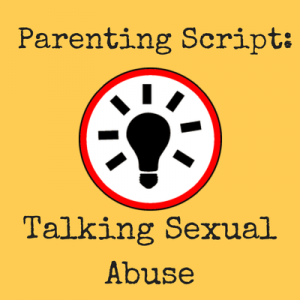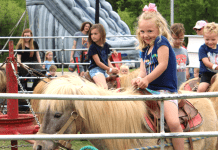This series is in response to Where’s My Parenting Script?! Please check back each Wednesday in the month of August for more tips.
 As noted in the first post of this series with all the increased awareness around safety today, it can become overwhelming to know what topics to cover and when. But when we take a closer look at the rates of incident for the various safety issues kids face, unfortunately sexual abuse prevention has to come near the top of our list. (Research estimates 1 in 4 girls and 1 in 6 boys) Many parents are unsure how to provide sexual abuse prevention strategies and at what age to start. It is actually sooner than you may think. Here are some recommendations you can start with even your littlest ones:
As noted in the first post of this series with all the increased awareness around safety today, it can become overwhelming to know what topics to cover and when. But when we take a closer look at the rates of incident for the various safety issues kids face, unfortunately sexual abuse prevention has to come near the top of our list. (Research estimates 1 in 4 girls and 1 in 6 boys) Many parents are unsure how to provide sexual abuse prevention strategies and at what age to start. It is actually sooner than you may think. Here are some recommendations you can start with even your littlest ones:
1) Body education: Teaching kids the proper name for their body parts, including private parts, is an early step in promoting healthy understanding, awareness and respect of their body. It also lays a foundation for open and honest dialogue on matters related to their body and sexual health.
2) You’re in charge of your body: Kids aren’t in charge of much early on but from a very young age you can reinforce the concept that your child is in charge of their body. Reinforce to them, family members and others that they are in charge when and how they want to share their body with hugs, hi fives, etc. Even with innocent tickling or rough-housing, reinforce if they say to stop that they are in charge of their body and that boundaries should be observed. You can talk about the few exceptions to this, like when you’re with them at the doctor. Or when my daughter was three, she tried to pull the “I’m in charge of my body” when it came to refusing to sit in her car seat one day. Those are great moments to talk through the finer points of the concept.
3) Okay and not okay touches: This is the language we use with little ones to talk about different kinds of touches. Not okay touches includes a spectrum of things like hitting, pinching, biting and the not okay private part touching by others. We also talk about confusing touches. You want to communicate that if a touch is uncomfortable or confusing and your child isn’t sure if it’s okay or not okay, they can check with you about it.
4) Assertiveness training: We want to reinforce to our kids how to say a strong “no” when they need to. I know it may feel like our kids master “no” early on but quickly we also start reinforcing compliance. Revisiting times they can tell others “no” can be helpful. Also talk through when to go to an adult and what adults they can go to in different settings. We often emphasize stranger danger when we think of safety in this area and can miss the reality that the vast majority of perpetrators are most often a trusted individual by not only the child but the parent as well.
5) Surprises vs. Secrets: The nature of child sexual abuse is secrecy. Perpetrators often reinforce the secrecy with a variety of tactics. You want to talk through the differences between surprises and secrets. Surprises are kept for a short time for something usually exciting like a birthday present. Secrets on the other hand are kept ongoing. You can teach them red flags of secrets are when someone says not to tell your parents or uses warnings or threats to reinforce the secret keeping.
The great thing about these core concepts are that they continue to be relevant as kids grow. These strategies also lay a foundation for prevention with other issues like bullying, substance abuse, dating violence, etc. You can adjust the language you use and talk about them with age appropriate scenarios. The dynamics and nature of child sexual abuse is that it is not always preventable but we are making progress in bringing this issue out of the shadows in this country. Education and open dialogue is the key in continuing to empower children and families on this issue.
Here are a few additional recommended parenting resources on this topic:
Online
The National Child Traumatic Stress Network is a great resource for free guides that they have compiled on this topic. This parent guide is a great basic review of normal sexual development and what safety education to provide at specific ages: Parent Guide – Sexual development and behavior
And a general fact sheet for parents: Child Sexual Abuse Fact Sheet
Books
There are lots of great books out there, here are few I’ve used in my practice and recommend for parents and kids:
Amazing You: Getting Smart about Your Private Parts by Saltz and Cravath (Age 3 and up)
Your Body Belongs to You by Spelman and Weidner (ages 3-6)
I Said No! A Kid to Kid Guide for Keeping Private Parts Private by King & Rama (Age 4 and up)
Check back next Wednesday for the third in this series: strategies for tackling bullying. Did you miss Heather’s post on Child Safety? Click HERE.
************************
 Heather Askew is a fellow metro area mom and a Licensed Clinical Social Worker that specializes in working with children and families impacted by trauma. She was born and raised in Oklahoma and moved to the metro area to attend college. She married her high school sweetheart and they have two of the best kids in the world. She is passionate about the joys and struggles of intentional living, matters of faith and the heart of parenting.
Heather Askew is a fellow metro area mom and a Licensed Clinical Social Worker that specializes in working with children and families impacted by trauma. She was born and raised in Oklahoma and moved to the metro area to attend college. She married her high school sweetheart and they have two of the best kids in the world. She is passionate about the joys and struggles of intentional living, matters of faith and the heart of parenting.



















This is a great article! Love the language provided for talking through these circumstances and the progression from beginning to teach body awareness to little ones and refining and elaborating up through teenagers. I am going to use all four of the recommendations with my kiddos and they are also useful to have as a teacher to modify for the classroom. I love the book suggestions and just put all 3 on reserve at the library to take a look at! Thanks for this great info presented so clearly!